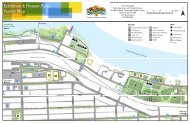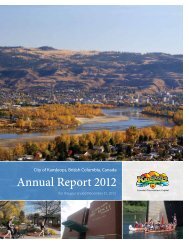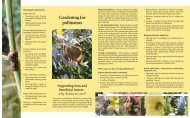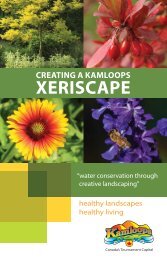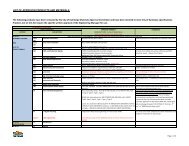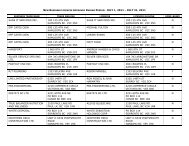Planting the seeds for a sustainable future - City of Kamloops
Planting the seeds for a sustainable future - City of Kamloops
Planting the seeds for a sustainable future - City of Kamloops
Create successful ePaper yourself
Turn your PDF publications into a flip-book with our unique Google optimized e-Paper software.
Trespassing; andClimate change.Due to global warming, it is predicted that wea<strong>the</strong>r throughout BC will generally become warmer year-round, wetter in winter,and drier in summer. The impact <strong>of</strong> <strong>the</strong>se changes on agricultural production is specific to <strong>the</strong> various climatic regions. Ingeneral, <strong>the</strong> potential <strong>for</strong> crop production in this region would likely be increased due to a higher potential <strong>for</strong> crop yieldresulting from more favorable climatic conditions, an expanded range over which some crops can be grown, and <strong>the</strong>introduction <strong>of</strong> new, higher-value crops. The degree to which this increased potential <strong>for</strong> crop production can be realized will beprimarily dependent on <strong>the</strong> availability <strong>of</strong> water. The predicted climate change will enhance production where crops can beirrigated; however, limitations to <strong>the</strong> supply <strong>of</strong> irrigation water may seriously affect productivity. Where irrigation is notfeasible, productivity may increase slightly, remain <strong>the</strong> same, or decrease and would be very sensitive to actual rainfalldistributions during <strong>the</strong> growing season. Considerable areas <strong>of</strong> land suitable <strong>for</strong> agricultural production are currently not in usein some regions due to lack <strong>of</strong> necessary infrastructure and increased costs associated with distant markets. Climate changemay increase <strong>the</strong> land in agricultural production; however, <strong>the</strong> area currently in production is controlled primarily by economicra<strong>the</strong>r than climatic considerations. Increased demand on existing water supplies from agricultural and non-agricultural usersis expected to occur throughout British Columbia.16. Pressure <strong>for</strong> Non-agricultural Developments on Agricultural LandsDevelopers <strong>of</strong>ten focus on agricultural lands due to <strong>the</strong>ir lower cost. Resort developments and golf course proposals typicallyinvolve a residential component to be viable and as a result <strong>the</strong> agricultural potential is almost always impacted in a negativeway. Care needs to be taken when reviewing such proposals to determine if <strong>the</strong>y are speculator driven or truly have a positiveagricultural benefit.SECURE FOOD SUPPLY AND PUBLIC AWARENESSThe majority <strong>of</strong> agricultural products produced in <strong>the</strong> region are typically shipped out <strong>for</strong> fur<strong>the</strong>r finishing or sale. This appliesto <strong>the</strong> cattle industry where most calves and yearlings raised in <strong>Kamloops</strong> are shipped to Alberta <strong>for</strong> fur<strong>the</strong>r finishing andeventual return through our retail food stores and restaurants. A few o<strong>the</strong>r examples include commodities such as milk,ginseng and o<strong>the</strong>r horticultural crops (e.g. potatoes and onions). These farms are <strong>of</strong>ten not well known or visited by localconsumers but <strong>the</strong>y should be recognized as a critical component to a secure food supply.HighPriorityCITY OF KAMLOOPS 56




